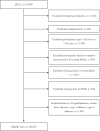Self-reported eating habits and dyslipidemia in men aged 20-39 years: the Japan Environment and Children's Study
- PMID: 37407489
- PMCID: PMC10331000
- DOI: 10.1265/ehpm.23-00008
Self-reported eating habits and dyslipidemia in men aged 20-39 years: the Japan Environment and Children's Study
Abstract
Background and aims: Unhealthy eating behaviors, including eating fast, eating after satiety, skipping breakfast, and eating out are common among men aged 20-39 years. In this cross-sectional study, we aimed to examine the association between self-reported eating habits and the prevalence of dyslipidemia.
Methods: The participants of this study were 38,233 men aged 20-39 years, whose food consumption frequency related information was collected through a questionnaire. Dyslipidemia was defined as total cholesterol (TC) ≥190 mg/dL, fasting triglyceride (TG) ≥150 mg/dL and non-fasting TG ≥175 mg/dL, high-density lipoprotein cholesterol (HDL-C) <40 mg/dL, low-density lipoprotein cholesterol (LDL-C) ≥140 mg/dL. Odds ratios (ORs) and 95% confidence intervals were calculated relative to healthy eating habits using logistic regression, after adjustment for age, study unit, and other potential confounding factors.
Results: Moderate and fast speeds were associated with a higher prevalence of reduced HDL-C (by 27% and 26%, respectively) compared to slow speeds. Eating after satiety was associated with a higher prevalence of elevated TC (by 16%) and elevated TG (by 11%), elevated LDL-C (by 21%). Breakfast eating of 1-4 times/week and <1 time/week were associated with a higher prevalence of elevated TC (by 11% and 16%, respectively) and elevated LDL-C (by 21% and 38%, respectively) compared to that of ≥5 times/week. Eating out of ≥5 times/week was associated with a 13% higher prevalence of elevated TG.
Conclusions: All of four unhealthy eating habits were associated with a higher prevalence of dyslipidemia in men aged 20-39 years.
Keywords: Dyslipidemia; Elevated TC; Elevated TG; Lipoprotein cholesterol; Self-reported eating habit; Young adult men.
Conflict of interest statement
All authors declare there are no conflicts of interest to report.
Figures
Similar articles
-
Prevalence of dyslipidemia and associated risk factors among Turkish adults: Trabzon lipid study.Endocrine. 2008 Aug-Dec;34(1-3):36-51. doi: 10.1007/s12020-008-9100-z. Epub 2008 Nov 12. Endocrine. 2008. PMID: 19003544
-
Low bone mineral density is associated with dyslipidemia in South Korean men: the 2008-2010 Korean National Health and Nutrition Examination Survey.Endocr J. 2013;60(10):1179-89. doi: 10.1507/endocrj.ej13-0224. Epub 2013 Jul 23. Endocr J. 2013. PMID: 23877056
-
Associations of thiocyanate, nitrate, and perchlorate exposure with dyslipidemia: a cross-sectional, population-based analysis.Environ Sci Pollut Res Int. 2023 Feb;30(7):17214-17225. doi: 10.1007/s11356-022-23296-y. Epub 2022 Oct 4. Environ Sci Pollut Res Int. 2023. PMID: 36194328
-
Dyslipidemia and its predictors among adult workers in eastern Ethiopia: An institution-based cross-sectional study.PLoS One. 2023 Oct 9;18(10):e0291665. doi: 10.1371/journal.pone.0291665. eCollection 2023. PLoS One. 2023. PMID: 37812638 Free PMC article.
-
Lipid Screening in Childhood for Detection of Multifactorial Dyslipidemia: A Systematic Evidence Review for the U.S. Preventive Services Task Force [Internet].Rockville (MD): Agency for Healthcare Research and Quality (US); 2016 Aug. Report No.: 14-05204-EF-1. Rockville (MD): Agency for Healthcare Research and Quality (US); 2016 Aug. Report No.: 14-05204-EF-1. PMID: 27559550 Free Books & Documents. Review.
References
-
- Mach F, et al.. 2019 ESC/EAS Guidelines for the management of dyslipidaemias: lipid modification to reduce cardiovascular risk. Eur Heart J. 2020;41(1):111–88. - PubMed
-
- Iso H, et al.. Fasting and non-fasting triglycerides and risk of ischemic cardiovascular disease in Japanese men and women: the Circulatory Risk in Communities Study (CIRCS). Atherosclerosis. 2014;237(1):361–8. - PubMed
-
- Cui R, et al.. Serum total cholesterol levels and risk of mortality from stroke and coronary heart disease in Japanese: the JACC study. Atherosclerosis. 2007;194(2):415–20. - PubMed
MeSH terms
Substances
LinkOut - more resources
Full Text Sources
Medical
Miscellaneous


